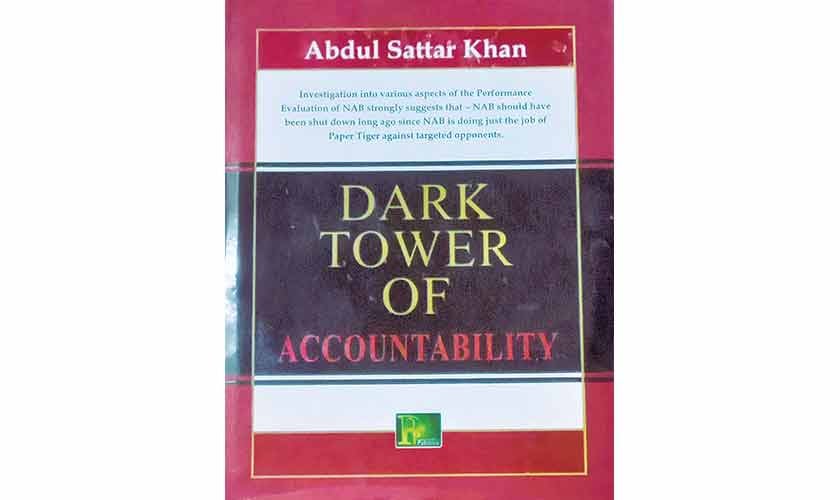**Abdul Sattar Khan’s *The Dark Tower of Accountability*: A Formidable Work on Systemic Corruption in Pakistan**
Abdul Sattar Khan’s *The Dark Tower of Accountability* is a formidable work. The book not only distills the essence of his investigative reporting spanning four decades but also lays bare the lofty claims made by various individuals associated with the National Accountability Bureau (NAB) — Pakistan’s premier agency for investigating high-profile corruption cases — regarding the recovery of looted public funds from convicted individuals.
It is worth outlining the key features that are likely to establish this book as a pioneering document on systemic organizational corruption in Pakistan.
### Defining the Scope of Investigation
The author clearly defines the scope of his investigative work as an examination of 4,098 NAB cases. He asserts that no systematic performance evaluation or professional financial audit of NAB has previously been undertaken. The debate surrounding NAB’s performance remains fragmented at best.
While politically high-profile cases continue to attract public attention and intensify the country’s political polarization, they also provide easily marketable content for both broadcast and print media. However, *The Dark Tower of Accountability* moves beyond sensationalism to present an in-depth analysis based on documents and records available on NAB’s official website.
### Highlighting the Lack of Accountability and Transparency
Even with this limited source material, the book highlights a persistent lack of accountability and transparency that has characterized NAB’s operations since its establishment in 1999. This is most notably reflected in the slow progress of thousands of cases that remain stuck at the inquiry stage—some for more than two decades.
In this context, one is left to wonder how such a glaring source of embarrassment for NAB has largely escaped scrutiny by both the media and the political opposition, considering the latter often finds itself at the receiving end of the agency’s work.
This apparent oversight mirrors the opposition’s recurring failure to critically examine the government’s fiscal performance, despite actual budget figures being publicly available on the Ministry of Finance’s website.
### Financial Discrepancies and Outstanding Recoveries
The book estimates that around Rs 24 billion remains outstanding in plea bargain and voluntary return settlements, alongside a further Rs 120 billion discrepancy in NAB’s financial accounts.
People who have been found guilty by NAB, along with spokespersons of major political parties—who often appear on live television to defend their leaders or criticize rivals—frequently ignore the agency’s inner workings. The author suggests this is less a matter of lack of access and more a reflection of insufficient sincere effort.
He argues that such individuals could have followed the investigative path he undertook to gain deeper insight into how and why adverse decisions were reached in their cases.
### A More Informed Understanding Through Comprehensive Study
The book contends that anyone who has studied the Panama Papers and the nine volumes of the Joint Investigation Team (JIT) report related to NAB cases can be trusted to have a more informed understanding of the agency’s operations than many political spokespersons who dominate prime-time television talk shows.
Even when investigative stories published in print make their way onto electronic media platforms, discussions tend to focus narrowly on specific aspects of NAB’s performance, rather than offering a comprehensive critique of the institution.
### Extensive Use of Credible Sources
Drawing on data from NAB’s official website, the nine volumes of the JIT report, and documents from Transparency International, *The Dark Tower of Accountability* examines both the documented workings of NAB and the reasons behind its poor performance.
It also highlights some previously overlooked or unexplained details, particularly concerning plea bargain and voluntary return cases under NAB’s remit. The author points to major discrepancies between the actual, determined, agreed, and deposited amounts in such cases, reinforcing the financial irregularities surrounding the institution.
### A Wide Array of Cases Covered
The book is highly readable due to the wide variety of NAB cases it covers. These range from cases involving high-profile political leaders — particularly the Sharifs — to those still at the inquiry stage despite the passage of two decades since their initial filing.
Cases examined include the Avenfield Apartments and Broadsheet cases, as well as the case involving the notorious “Double Shah.” This diversity of case studies provides readers with a comprehensive overview of NAB’s functioning.
### A Compendium for Investigative Journalists
Alternatively, Abdul Sattar Khan’s *Dark Tower of Accountability* serves as a valuable compendium for aspiring investigative journalists. It highlights the importance of documentary evidence and elaborates on the various stages of a NAB probe — starting with the filing of a complaint, its validation, followed by the inquiry and investigation stages, and culminating in the submission of a reference.
—
**Book Details:**
**Title:** *Dark Tower of Accountability*
**Author:** Abdul Sattar Khan
**Publisher:** Peace Publications, Lahore
**Pages:** 142 (Hardbound)
**Price:** Rs 4,995
*The Dark Tower of Accountability* is a significant contribution to understanding systemic organizational corruption in Pakistan and sheds light on the challenges inherent in holding a major accountability institution accountable itself.
https://www.thenews.com.pk/tns/detail/1345056-the-devil-in-the-detail
